Table of Contents

To maintain a lush, green lawn, remove the thatch that prevents water and fertilizer from reaching the grass’s roots. You know that, like a house, your lawn needs a thorough spring cleaning. Outdoor “deep cleaning” concentrates on dethatch buildup that may deprive your lawn’s root system of the water, air, and other nutrients needed to stay lush and healthy, much like an inside “deep cleaning” removes dust and grime from ceiling lights to baseboards.
This article will provide you with a complete guide about when and how to dethatch a lawn, the reasons for dethatching, and many more about it.
Dethatching – Why it is necessary to dethatch the lawn?
Dethatching isn’t necessary for every lawn, but knowing how to handle it is essential if you want your grass to thrive. Regular dethatching can revive your lawn’s health and preserve its beauty for years. Keep your thick, luscious grass on track by understanding why, how, and when to dethatch the lawn.
What is thatch?
Thatch is the accumulated layer of dead and living grass stems, roots, and shoots that sits above the soil and beneath the green vegetation. Some thatch is natural and helpful, but you should keep it to a minimum. It adds a little bounce to the grass, which is excellent for running toddlers and golf balls. Additionally, a thin covering insulates the soil from temperature swings and makes the grass more wear-resistant.
The type of grass dramatically affects the severity of thatch problems. However, it might become a severe issue for some who tend to accumulate thatch quickly. For lawns already in trouble, this is especially important to remember.
Reasons for Accumulation of thatch
Some frequent reasons for an excessive accumulation of thatch are:
- Over-fertilization and over-watering stimulate grass growth. However, this can outpace the grass’s natural decomposition of thatch, leading to a buildup of the latter.
- Over-mowing occurs when the grass is cut at an excessive height.
- Wet, sticky clay
- Overuse of insecticides and fungicides, which kill or restrict the development of soil microorganisms and earthworms.
- It is common that thatch is made from grass clippings. However, the accumulation of roots, rhizomes, stolons, and decaying leaves constitute thatch.
When to dethatch lawn?
Before dethatching, you should always inspect the lawn’s thatch layer. Get out your spade or trowel and cut off a little bit of your property to test. You may examine the thatch layer and get precise measurements. Weak, sparse growth and uneven coloration of your grass are telltale signals that your thatch is 1 to 2 inches thick. The time has come for dethatching once it has been established that the thatch on your roof has grown beyond a certain safe threshold.
As with other significant lawn operations like sodding or planting new grass, dethatching is best done when your grass is actively growing. Your lawn will recover more quickly if you encourage new grass growth. Dethatching must be timed according to whether you have cool-season or warm-season grasses. The development habits of the two blades of grass are distinct. Ideally, it would help if you dethatched during a period of rapid development.
Early fall
The dethatching process should be conducted in the spring or late summer/early fall when cool-season grasses like Kentucky bluegrass are actively growing.
Warm-season
Again, the best time to dethatch warm-season grasses like Zoysia, Bermuda, and St. Augustine grass is in the summer, when they’re actively growing.
Procedures:
Your grass can benefit from aerating and dethatching, two distinct procedures.
- Aeration works by extracting soil cores, eliminating the thatch layer, and opening channels for water and nutrients to reach the ground below. It hastens the decomposition of existing thatch and helps get it ready for removal.
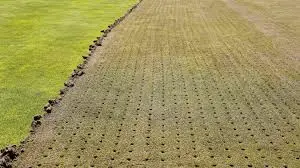
2. Dethatching is a method for cutting through layers of thatch and collecting organic materials to reach the soil below.
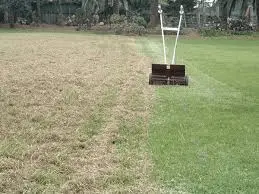
Techniques and Tools for Dethatching
The best tool for dethatching will depend on the size of your landscape and your willingness to put in the time and effort. Manual thatching rakes are popular and can be found in most lawn and garden stores for smaller lawns and lighter thatch management throughout the growing season.
You should probably get a pro to do this if your thatch is more than 2 inches thick. It usually takes more than one trial to get rid of heavy thatch, and doing so too quickly will harm the grass’s roots. There are three techniques to dethatch your lawn on your own:
Manual dethatching
Heavy, short-tined rakes with curved blades are used with a dethatching manual to dig into your lawn and pull out thatch as you rake. Light thatch and regular thatch maintenance on smaller lawn areas can be handled using a dethatching rake.
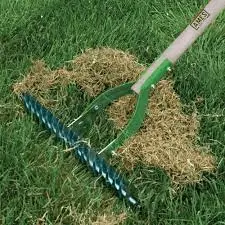
Power rakes
It can compare mowers to power rakes, similar to mowers but with revolving rake-like tines that dig into the soil and pick out thatch. Lawns with a sparse thatch layer and the grass are sturdy enough to endure vigorous raking and benefit significantly from using power rakes.
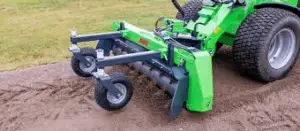
Vertical mowers
The vertical blades of a vertical mower, also known as a verticutter, penetrate the thatch layer and into the soil, bringing the thatch and, in many cases, the grassroots with it. When renovating an older lawn with a lot of thatch, a verticutter is your best bet. The amount of thatch removed at once can be adjusted by the blades.
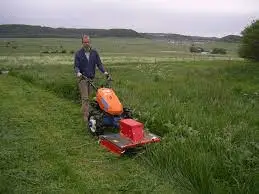
After Dethatching, What Should You Do?
When you dethatch your lawn, it can look untidy. Stop worrying; this situation won’t persist forever. Please remove the trash and thatch by putting them in a compost pile. Using thatch as a fertilizer is a fantastic environmentally friendly option. After cleaning up your garden spread a thin layer of compost over your grass and water it thoroughly. This will aid in the development of thick grass. March is an excellent time to plant grass seeds in bare places so that they can grow in time for summer.
Keep the soil pH and nutrient levels at their optimal levels for thick, healthy grass growth by testing the soil every three to four years. Lime can be used to correct the soil pH and encourage the development of beneficial microorganisms that break down thatch in your grass.
You should aerate heavy or compacted lawns periodically, and gypsum should be added as an amendment to assist in loosening soil and promoting root growth. Fertilize the property based on a soil test. Fertilize it properly using the best lawn fertilizers to supply the nitrogen it needs without applying too much, then mow it regularly and water sparingly.
End Note
It is concluded that Dethatching might not be something you have to do every year, but you should still inspect your lawn for thatch at least once a year. You can put off getting out the thatching rake if there is less than half an inch of thatch and no symptoms of discomfort in the grass. If u want to dethatch your home lawn for any reason then, this article will help you with when and how to dethatch a lawn.
